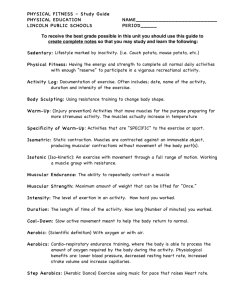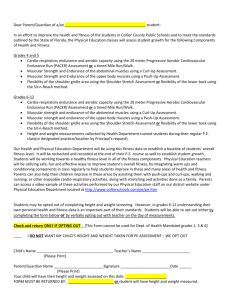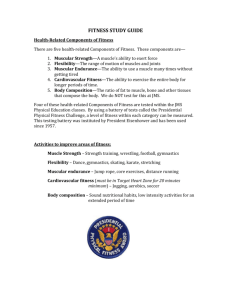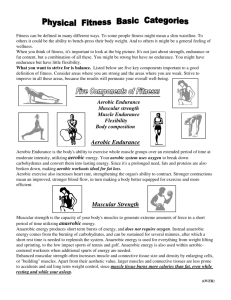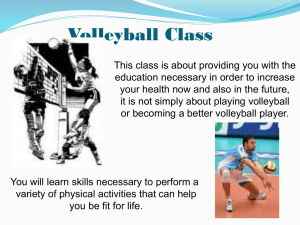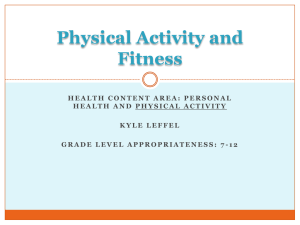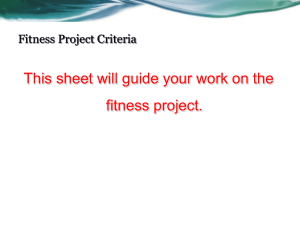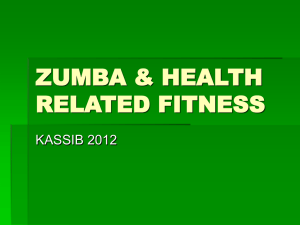Physical_Activity-Unit_2
advertisement
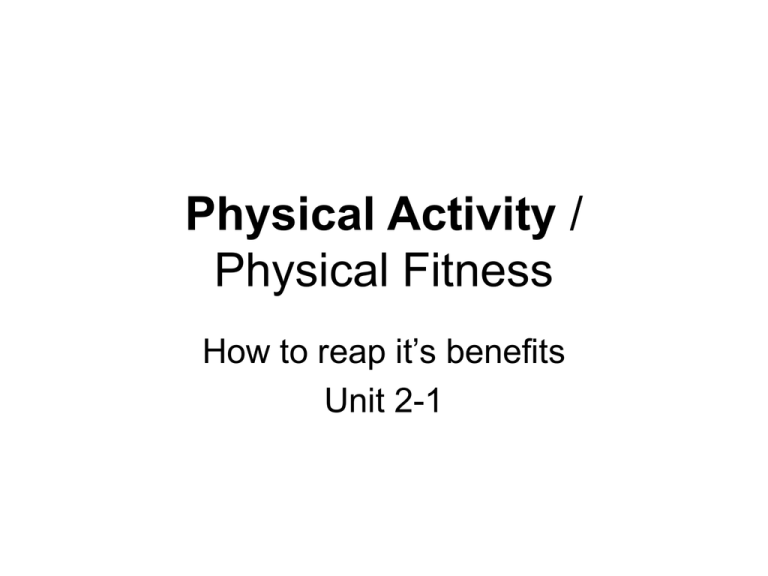
Physical Activity / Physical Fitness How to reap it’s benefits Unit 2-1 Bell Ringer "No Pain, No Gain" • Do you agree or disagree that exercise must be painful and that you have to exercise to the point of pain to reap the benefits of physical activity. Health benefits of physical activity include: • Reduces risk for… -heart disease by strengthening the heart muscle -stroke (brain attack) -some types of cancer What else does it do? Mental/emotional benefits include: • • • • • Causes an increase in endorphins Causes an increase in serotonin levels May help prevent depression Decreases anxiety levels Releases anger, frustrations or tensions of everyday life • Increases creative thinking and mental sharpness • Increases energy levels • Makes you feel good about yourself and increases confidence Social benefits include: • Opportunity to share time with friends and family • Q What are some physical activities that you can enjoy throughout your life? Five components of physical fitness 1. Aerobic endurance/cardio-respiratory fitness 2. Muscular strength 3. Muscular endurance 4. Flexibility 5. Body composition Cardio-respiratory Endurance/ Aerobic Fitness 1. Cardio respiratory endurance-the ability of the heart, lungs, and blood vessels to utilize and send fuel and oxygen to the body’s tissues during long periods of moderate-to vigorous activity. Q List 5 aerobic activities. Muscular Strength and Endurance 2. Muscular Strength-the amount of force a muscle can exert 3. Muscular Endurance-the ability of the muscles to perform physical tasks over a period of time without becoming fatigued Flexibility and Body Composition 4. Flexibility-the ability to move a body part through a full range 5. Body composition-the ratio of body fat to lean body tissue, including muscle, bone, water, and connective tissue such as ligaments, cartilage, and tendons. Measuring Fitness 1. Cardio-respiratory / fitness Aerobic endurance -PACER Test 2. Muscular strength-Push Ups / Sit Ups 3. Muscular endurance-Push Ups/ Sit Ups 4. Flexibility-Sit-and-Reach 5. Body composition-BMI Improving Your Fitness • Aerobic Exercise-any activity that uses large muscle groups, is rhythmic in nature, and can be maintained continuously for a least 10 minutes three times a day or for 20 to 30 minutes at one time (running, cycling, swimming, and dance) • Anaerobic Exercise involves intense short bursts of activity in which the muscles work so hard that they produce energy without using oxygen (running 100-meter dash and lifting weights) Improving Muscular Strength and Endurance • Anaerobic exercises improve muscular strength and endurance • The more work the muscles do, the stronger they become • Examples: Resistance or strength training Free weights, exercise machines, or your own body weight can provide resistance Increasing flexibility • Increasing flexibility is most effectively achieved through stretching • Stretching lengthens the muscles • The most important areas in which to maintain flexibility are the neck, shoulders, hamstring muscles, chest and hips • It is important to never stretch a cold muscle Always warm up before stretching with some light activity • Never bounce when stretching, and don't stretch to the point of pain Improving and Maintaining Bone Strength • Healthy behavior you engage in related to Physical Activity and Nutrition can affect the health of your skeletal system now and later in life • Resistance training and weight baring aerobic activities Learning your fitness level and taking stops to improve it shows that you accept responsibility for your own health. You are the only one that has to live in your body… Take RESPONSIBILITY for it Reviewing Facts and Vocab • Identify and describe the five areas of health related fitness • Examine and briefly describe the relationship among body composition, diet, and fitness • Examine and briefly describe the effects of resistance training on the muscular and skeletal systems Thinking Critically • Hudson has been doing 50 curl-ups each day. Explain what area of health-related fitness this exercise benefits. What other types of physical activities or exercises should Sam add to his routine to improve his total health related fitness. • Estella, who has asthma, wants to begin an exercise program. She is thinking of signing up for a high-impact aerobic class. Is this a good strategy for Estella? Explain your answer. Compare and contrast • Describe the difference between aerobic and anaerobic exercise. Write a few sentences explaining how each contributes to a physical activity program. Applying Health Skills • Help a family member determine their target heart ranges. Then make a list of aerobic activities you could do together. Determine how you all could use this information to improve your cardiorespiratory endurance. *Remember: Get a health screening before beginning an exercise program.
